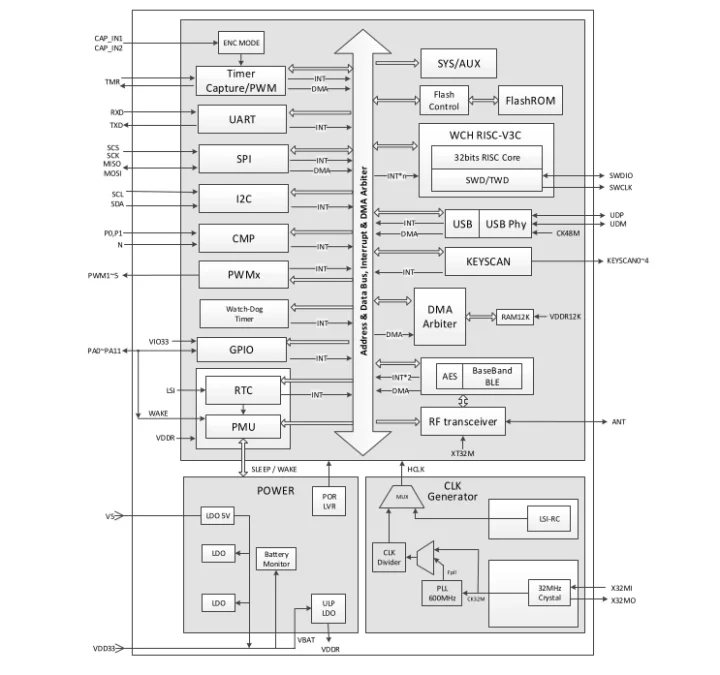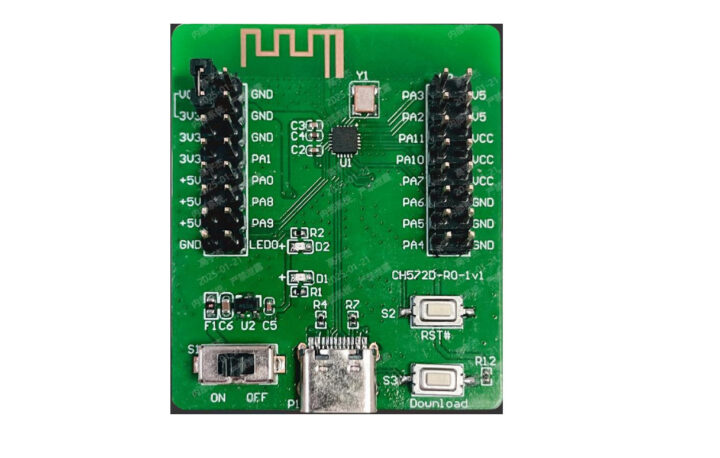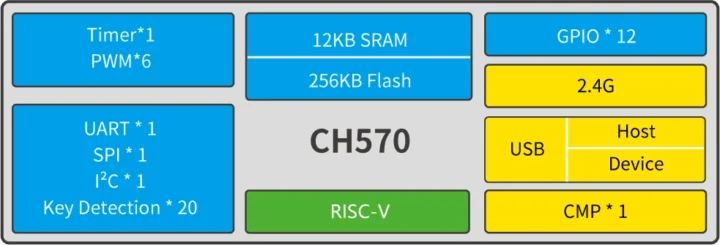Patrick Yang, CTO at WCH, has recently unveiled the CH570 RISC-V SoC with 2.4GHz wireless and USB 2.0 (host & device) as an upgrade to the popular CH32V003 general-purpose RISC-V MCU with more features at the same low price (10 cents).
CH570 also comes with 12KB SRAM and 256KB flash (vs 2KB SRAM and 16KB flash for the CH32V003), offers up to twelve GPIO, six PWM, I2C, UART, SPI, and a 20-channel key detection module. There’s also the CH572 with the same features, except it also supports Bluetooth LE 5.0. As a side note, I wrote about the CH572 RISC-V MCU with BLE in 2019, but I guess it was scrapped likely because it had OTP instead of flash…, and the new CH572 (2025) is different.
WCH CH570/CH572 specifications:
- CPU core
- QingKe 32-bit RISC-V3C core @ up to 100 MHz (RV32IMBC instruction set and custom instructions)
- Low-power 3-stage pipeline
- High-speed interrupt response mechanism
- Memory – 12KB SRAM
- Storage – 256KB non-volatile memory
- 240KB code flash (user application)
- 8KB system boot program memory area for bootloader
- 8KB for configuration (InfoFlash)
- Wireless
- 2.4GHz RF transceiver, baseband, and link control
- Support GFSK digital modulation and demodulation
- Rx sensitivity – -95dBm, programmable
- Tx power – Up to +7.5 dBm
- CH572 only – Bluetooth LE 5.0 with support for up to 2 Mbps data rates
- Peripherals
- USB 2.0 host/device controller and PHY
- Up to 12x GPIO, one with 5V signal input
- 1x UART up to 12.5 Mbps
- 1x SPI, 1x I2C
- 6x PWM (1x 26-bit, 4x 15-bit)
- 20-channel key detection (10-channel matrix area keys and 10-channel independent area keys)
- Analog – “16-speed” reference voltage, equivalent to 4-bit ADC.
- Timers
- 26-bit timer
- 2x watchdog timers (independent and window)
- 32-bit system timer
- Debugging – 1-wire/2-wire serial debug
- Security – AES-128 encryption and decryption, unique chip ID
- Misc – RTC
- Power management
- Built-in 5V to 3.3V regulator LDO5V
- Single 5V supply rated voltage: 5V
- Or single VDD33 power supply rated voltage: 3.3V
- Power Consumption
- Idle mode: 1.7mA
- Halt mode: 1.3mA (PLL/HSE not stopped)
- 420uA (PLL/HSE stopped)
- Sleep mode: 0.46uA~1.2uA multiple gears
- Shutdown mode: 0.3uA~0.9uA multiple gears
- Optional low-power battery voltage and low voltage monitoring
- Packages – TSSOP16 (5×4.4mm), QFN20 (3x3mm), SOP8 (5×3.9mm), DFN10X3 (3x3mm)

You’ll find the datasheet on the WCH website, but not much else for now. If you are interested, Patrick plans to give away 10,000 chips and 5,000 evaluation boards for free. The first 300 pieces are now offered on AliExpress with the $5 OFF voucher code XJI0YRGF5ZXY. Two options are available: the board only, or the board with two CH570D MCUs. Alternatively, if you have an address in China, you can DM him directly.

There are, however, more details on GitHub with PDF schematics, code samples in C for the MounRiver IDE, and documentation in Chinese. The development board is based on the CH572 RISC-V MCU and features a USB-C port, two 16-pin GPIO headers, a PCB antenna, Reset and Download buttons, and a power LED.

Update: The article was initially published on March 15, 2025, and update on April 2 following availability of the board and chip on AliExpress

Jean-Luc started CNX Software in 2010 as a part-time endeavor, before quitting his job as a software engineering manager, and starting to write daily news, and reviews full time later in 2011.
Support CNX Software! Donate via cryptocurrencies, become a Patron on Patreon, or purchase goods on Amazon or Aliexpress






Can it also do 2.4Ghz Wifi?, or just BT
Just Bluetooth LE or proprietary 2.4 GHz.
The ‘proprietary 2.4GHz’ seems to be a Nordic NRF24 compatable kind of mode, but that has not been verified, yet.
I think you mean ‘OTP’ instead of ‘OTG’.
Amazing what you can get for $0.10 these days.
Pity the ADC is dropped (4-bit is poor substitute).
The 4 bit isn’t even an A/D, it’s a ladder comparator. You can switch it around to have different taps connected to the comparator and you can itterate through the voltage taps to approximate a 4 bit A/D, but it’s a complete manual process and it will be error prone as there is no sample and hold. Calling it an A/D is giving it too much credit.
It’s probably useful as a single wire keyboard decoder like they use on cheap mp3 player chips where you have different control buttons each connected to a common pin through different resistor values and the chip senses which button is pressed based on the different voltages from the different resistor ratios.
12k ram for a Bluetooth enabled chip? 4bit adc? I guess you could make a very cheap usb-bt adapter with this?
I’m guessing it would make a nice multi protocol keyboard/mouse dongle. The CHxxx chips from WCH tend to be made for purpose. Sometimes they convey that purpose to the wider customer base and sometimes it’s kept private between WCH and whatever big customer came in and said “I’d like 100 million chips with this spec” that it was designed for.
Honestly, they remind me a lot of Motorola back in the 90’s when their microcontroller product line was a complete mess because they didn’t design parts to fill out a nice product table, they made chips specifically for large volume customers and then later resold them to the wider market. Need a chip with 1 serial port? Sure. Need 8? Yes, we have one like that. Need 2? Oh, sorry, no one ever asked for two before. We can design you one. First sign this NDA and deposit $1,000,000 to this account and we’ll get right on it.
There is some effort at CNLohr’s discord to add support for this chip to the newly renamed CH32fun library (the 003 has been removed as it support way more chips than just the 003 and that was starting to confuse people). The chip itself is a bit of a mess peripherial wise. The lack of an A/D is a big problem for some. It also lacks a high speed internal oscillator. You have to use a 32MHz external XTAL or use the 32KHz internal low speed oscillator.
The WCH design guide says to keep the XTAL lines away from interference, but they put them *right next to* the RF pin.
We’re hoping to get some dev boards and/or chips to work with. In the mean time there’s a member of the discord working on a few different CHxxx chips.
Also, FWIW, the CH32V00X chips have recently been added to the supported list. They’re finally becoming available on Aliexpress in reasonable quantities.
This chip has awful power consumption. Just spend $0.60 and get a TI BLE chip which draws nanoamps in sleep mode. The TI BLE software is well tested and mature.
I’m guessing table 19-3 (p.143 CH572DS1.PDF) 1.7mA figure for “Idle mode, enable the clock combination of each module” is just poorly worded seeing how table 5-3 (p.48 CH572DS1.PDF) says it’s 1.1uA for bluetooth+ram+core idling.
The TI chip we use is 765nA with 32KB RAM retention, 165nA with a tiny amount of RAM retained (few hundred bytes). This makes a huge different for battery powered devices since they spend 99.9% of the time asleep. The data we need to maintain is tiny so we can run in the 165nA mode. This translates to 6X the battery life compared to this chip. The newest TI chips are even lower power.
For us, the sensor chips are eating more power than the CPU does. So we been looking into reducing that.
[ Do you have a ‘self-discharge’ number (uA?) for the batteries You are using?
For lithium-ion there are numbers with 5-100uA for each 1Ah, at about room temperature. Seems that also has quite some influence, what battery to choose (exceptional ‘low self-discharge NiMH ~0.25%/month’ (eneloop), ‘0.5-3% per month’ for average/custom lithium-ion). And self-discharge currents can vary for a period from full charge to disconnect voltage before a recommended lowest state-of-charge (SOC).
The battery size can be smaller with lower consumption, since self-discharge then only adds up with longer periods above additional consumption from devices.
It is astonishing these devices are capable of compute work at 165nA. (thx) ]
At the level of uA/nA draw, its usually better to use non-rechargeable lithium button cells, negligible self-discharge, multi-year battery life (e.g. Bluetooth trackers and Casio watches)
We use ordinary coin cells in a design similar to this:
https://www.ti.com/tool/TIDA-00489
that is the proprietary RF version, here is the Bluetooth verison
https://www.ti.com/tool/TIDA-00759
Designs like those really do work. I have an old prototype unit in the lab from a previous generation and it is still sending data after 12 years. Most of the other ones died in the 8-10 year range. The current designs are even more power efficient.
This dev board is key to doing designs like this:
https://www.digikey.com/en/products/detail/texas-instruments/LP-XDS110ET/19236267
It lets you measure the power consumption of your designs at the nanoAmp level over time. So when the device wakes up you can profile all of the power it uses while it is sending with microsecond granularity.
> The TI chip we use is 765nA with 32KB RAM retention
WCH CH570/572 RAM retention – 0.6uA.
Which TI BLE chip is available for $0.60?
I should explain the technique used to achieve 10 year lifetimes in BLE devices. The simple answer — these devices are transmit only. They never turn the receiver on. So how do you secure a transmit only device? The answer is actually quite old, you use rolling codes from garage door openers. Rolling codes are based on pseudo random number generators which start from a seed. So when you first put a battery into our devices they transmit a random seed for a few seconds. To bind to the device you have to record that seed in the host. Once the host and the transmit-only device have the same seed their encryption is synchronized. If the host sees a packet which doesn’t decrypt it assumes it has missed some packets and searches forward in the pseudo random number sequence. Use a 128b pseudo random number generator and no one is going to crack this. So the devices go to sleep for a few minutes, wake up to do a sensor reading, check if it has changed, then if it has changed enough send an encrypted packet. After you send the packet, move to the next pseudo random number — and that’s the tiny bit of data which needs to be retained.
This is pretty confusing, is the only difference between the 570 and 572 the bluetooth software stack? I.e. the same RF stuff in both? If the 570 will be 10 cents, will they offer the 003 at 5 cents or anything like that? Like everyone else I’m bothered by the power consumption and lack of an ADC in this part. The 003 was better in those regards I think.
I think it’s probably just a Bluetooth license issue.
I agree, they probably don’t own their BT stack and are paying a royalty to use someone else’s. Maybe someone will port free code onto the chip.
It’s up on AliExpress in limited quantities.
Some people are complaining that AliExpress won’t ship to their country.
> Some people are complaining that AliExpress won’t ship to their country.
I saw that message, but it was when there was an “Out of stock” message at the same time. 10 minutes later there were 4 in stock and the “won’t deliver to your country” (New Zealand) message was gone and I successfully ordered one, with the discount.
It’s showing “Sorry, this item is no longer available” and “This product can’t be shipped to your address.” and “Quantity 0” again now.
If you see that, just check back later.
You’re right. It looks like they don’t list the 300 pieces in one go. Yesterday, it was out of stock with 17 pieces sold within about 30 minutes after the tweet. I saw they added more this morning, so I updated the post.